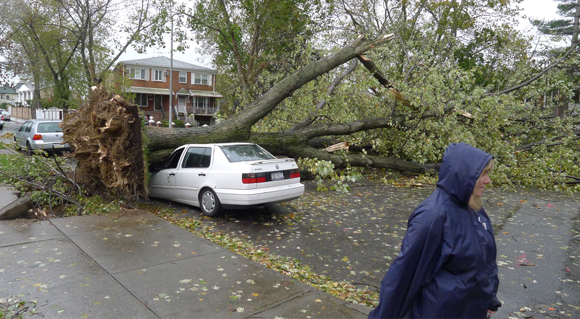HIGH WIND WARNING REMAINS IN EFFECT FROM 1 PM THIS AFTERNOON TO 4 AM EST THURSDAY…
* LOCATIONS… NEW YORK CITY… LONG ISLAND… COASTAL CONNECTICUT… HUDSON COUNTY… AND SOUTHERN WESTCHESTER COUNTY.
* HAZARDS… DAMAGING WINDS.
* WINDS… NORTH 25 TO 35 MPH WITH GUSTS UP TO 60 MPH.
* TIMING… THIS AFTERNOON AND TONIGHT.
* IMPACTS… WINDS OF THIS MAGNITUDE WILL BE CAPABLE OF PRODUCING DOWNED TREES AND POWER LINES… AS WELL AS MINOR PROPERTY DAMAGE.
PRECAUTIONARY/PREPAREDNESS ACTIONS…
A HIGH WIND WARNING MEANS A HAZARDOUS HIGH WIND EVENT IS EXPECTED OR OCCURRING. SUSTAINED WIND SPEEDS OF AT LEAST 40 MPH OR GUSTS OF 58 MPH OR MORE CAN LEAD TO PROPERTY DAMAGE.
Due to the storm New York area, all NYC parks, playgrounds, and beaches will be closed from Wednesday, November 7 at noon until Thursday, November 8 at noon.
To ensure sanitation crews continue to provide 24-hour-a-day cleanup services to Staten Island, south Queens, and southern Brooklyn to clean up storm debris, garbage collections may be reduced from three days to two days or from two days to one day in areas not heavily impacted by the storm. No recycling pickups until further notice.
Visit the Department of Education website for details about school openings and relocations. Please check back later in the day as information is continuously being updated.
Visit coned.com for the latest on the restoration efforts. To report a loss of electric service, contact Con Edison at 1-800-75-CONED(26633) or online at coned.com.
Alternate Side Parking regulations are suspended citywide on Wednesday, November 7, to facilitate storm recovery efforts. All other parking regulations, including parking meters, remain in effect.
Get the latest CUNY College closure information at www.cuny.edu
National Flood Insurance Program Information:
FEMA is still primarily in its response phase however, we want to begin the outreach to National Flood Insurance Program (NFIP) policy holders to assist with claims applications.
The FEMA Call Center at 1-800-621-FEMA (3362) is currently operating seven days a week from 7 a.m. to 10 p.m. (local time) until further notice. The Call Center can provide answers to general questions about the NFIP and can direct callers to other NFIP areas according to their needs.
NFIP policy holders who have experienced a flood can file a flood insurance claim by following three steps:
STEP ONE:
After experiencing a flood, NFIP policy holders should contact their agent or insurance company to file a claim. An adjuster should contact the policy holder within a few days of filing your claim. If policy holders do not hear from an adjuster, they can contact their insurance agent or company again. Make sure you have the following information handy:
•The name of your insurance company
•Your policy number
•A telephone and/or email address where you can be reached at all times
STEP TWO:
Separate damaged from undamaged property. Your adjuster will need evidence of the damage to your home and possessions to prepare your repair estimate.
•Take photographs of all of the damaged property, including discarded objects, structural damage, and standing floodwater levels.
•Make a list of damaged or lost items and include their date of purchase, value, and receipts, if possible.
•Officials may require disposal of damaged items so, if possible, place flooded items outside of the home.
STEP THREE:
Your adjuster will provide you a Proof of Loss form for your official claim for damages. You'll need to file this claim with your insurance company within 60 days of the flood. This document substantiates the insurance claim and is required before the National Flood Insurance Program (NFIP) or insurance company can make payment.
You'll receive your claim payment after you and the insurer agree on the amount of damages and the insurer has your complete, accurate, and signed Proof of Loss form. If major catastrophic flooding occurs, it may take longer to process claims and make payments because of the sheer number of claims submitted.
Additional NFIP Resources (the hyperlinks below may take less time to access than the links in the attachment)
FEMA is providing below the links to National Flood Insurance Program outreach materials for three different audiences (consumers, officials talking to consumers, and insurance agents.) Spanish language materials for consumers are included. Please share these outreach materials with constituents, local officials, and insurance agents in your districts and states.
Consumers
After a flood (English): http://www.floodsmart.gov/floodsmart/pages/preparation_recovery/after_a_flood.jsp
After a flood (Spanish): http://www.floodsmart.gov/toolkits/spanish/downloads/spanish/despues-de-la-inundacion.pdf
How to file a flood insurance claim (English): http://www.floodsmart.gov/floodsmart/pages/preparation_recovery/file_your_claim.jsp
How to file a flood insurance claim (Spanish): http://www.floodsmart.gov/toolkits/spanish/downloads/spanish/consejos-para-presentar-un-reclamo.pdf
Summary of Coverage (English): http://www.floodsmart.gov/floodsmart/pdfs/NFIP_Summary_of_Coverage.pdf
Summary of Coverage (Spanish): http://www.floodsmart.gov/toolkits/spanish/downloads/spanish/programa-nacional.pdf
Claims Handbook: https://agents.floodsmart.gov/manageagent/claims-and-services/filing-process
Managing Your Flood Insurance Claim (English): http://www.floodsmart.gov/toolkits/flood/downloads/ManagingYourFloodInsuranceClaim08-2008.pdf
Managing Your Flood Insurance Claim (Spanish): http://www.floodsmart.gov/toolkits/spanish/downloads/spanish/manejando-reclamacion-de-inundacion.pdf
Flood Insurance Requirements for Recipients of Federal Disaster Assistance: http://www.fema.gov/library/viewRecord.do?id=3323
As we continue our response and begin our recovery efforts, the administration’s top priority is to continue supporting the governors, tribal leaders and communities in impacted states. Coordinating through FEMA, we are committed to bringing the resources of the federal family to support the states, tribes and communities that have been affected by Hurricane Sandy. We continue to work side by side in close coordination with state, local and tribal emergency management officials, voluntary and faith-based communities, and private sector.
FEMA's mission is to support our citizens and first responders to ensure that as a nation we work together to build, sustain, and improve our capability to prepare for, protect against, respond to, recover from, and mitigate all hazards.



